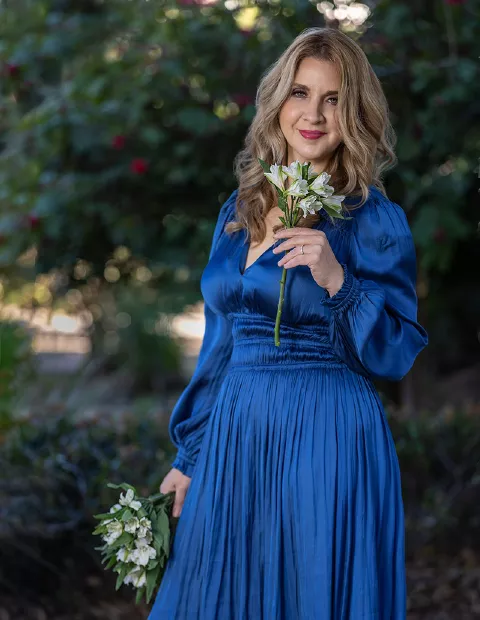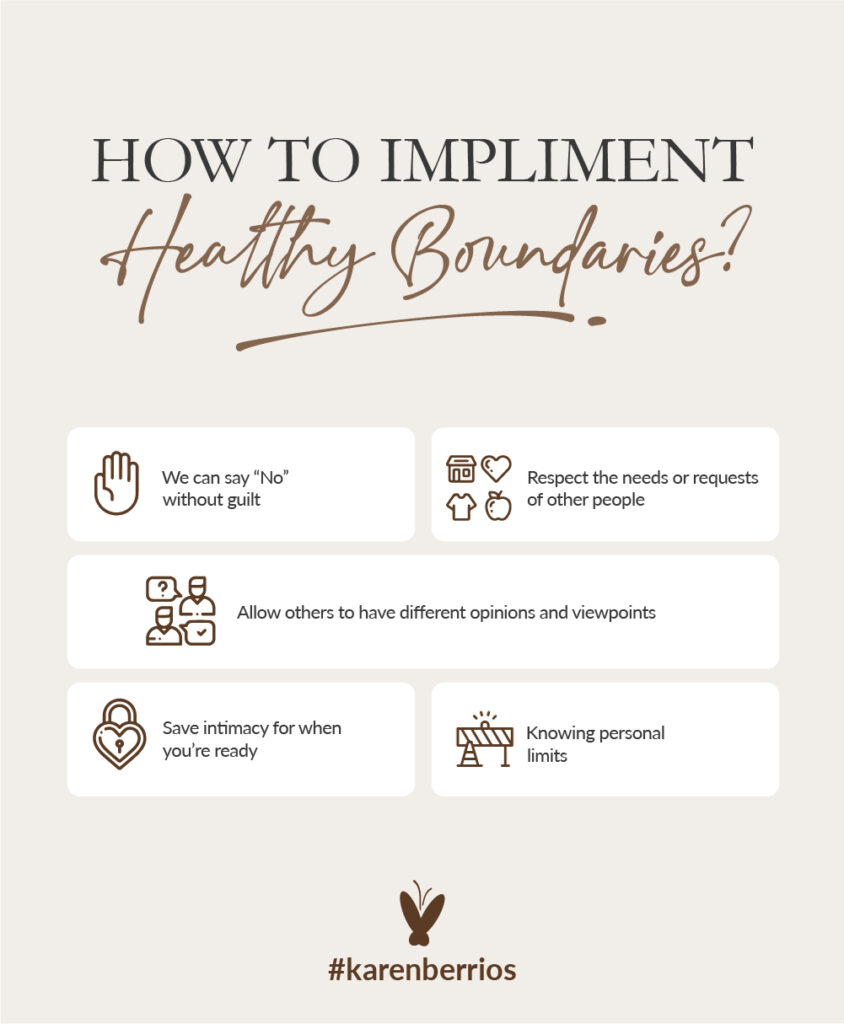

What Are Healthy Boundaries?
Just like anything in life, we have the choice to use healthy or unhealthy behavior in a situation. Similarly, our boundaries can be healthy or unhealthy. Boundaries can be described as non-negotiables, or lines in the sand. They can be open, clear, rigid, or firm. In some aspects, they can even seem controlling in nature. For example, open boundaries may leave room for negotiation, where rigid boundaries are concrete and strong.
To add, healthy boundaries aim to protect and keep us safe while respecting another person. This means we are considerate of the emotions, freedom and wellbeing of other people while protecting our own. Equally, we understand they don’t have an intent to hurt us if they do, in fact, overstep their boundaries. According to VeryWellMind, healthy boundaries mean:
- We can say “No” without guilt
- When others say “No” we respect their decision
- Respect the needs or requests of other people
- Allow others to have different opinions and viewpoints
Healthy boundaries mean we respect people’s things, their time and energy. Because of these healthy boundaries, we may not overshare intimate life details, or loan out money we have gotten back from friends or family. Additionally, we may decide to gently state boundaries with those closest to us. In turn, they understand our positive intentions. As a result, they may respect our boundaries.
Normally, healthy boundaries can be both gentle or firm in speech, but still have the end result of expecting cooperation and respect from someone else. Furthermore, they can in turn protect the following aspects of our lives from being damaged, exploited, unappreciated and disrespected. These include:
- Physical
- Sexual
- Spiritual
- Intellectual/creative
- Time
- Material
Lastly, we can advocate for our rights to be respected when we decide to use healthy boundaries.
What Are Unhealthy Or Poor Boundaries?
If healthy boundaries encourage strength, and healthy self-respect and keeps us safe, then we can imagine what unhealthy boundaries do. They can keep us in places or situations that harm us. Unfortunately, they can keep us accepting abuse from people to feel loved. We can also remain at the beck and call of people who have shown us they have little to no respect for us.
Moreover, we can allow others who don’t take our “No” seriously to walk all over us. Last, but not least, unhealthy boundaries can also allow us to take advantage of others, as we don’t accept theirs, and push our agenda.
Unhealthy boundaries can come from unmet needs and an attempt to get those needs met. For example, people pleasers and codependent people may struggle to create and uphold healthy boundaries because of a need to be liked and accepted by those around them. In turn, they may struggle with saying “No” without feeling they have to explain themselves. They may also be more open to having people influence their boundaries and even encourage them to reconsider them.
To add another point, they may be unable to figure out how involved they should get in others’ lives. They may fight others’ battles instead of knowing when to opt-out due to their inability to have boundaries with themselves as well. They may even secretly resent people who use them but they don’t create boundaries to let them know. Some may feel dictating and maintaining boundaries is hostile, and if they prefer to avoid conflict, may not find the courage to take a stand.
Poor or unhealthy boundaries can cause people to get attached to people for various reasons. Where healthy boundaries can cause us to create mutually respectful relationships, unhealthy boundaries can attract people who don’t value us, or seem to take advantage of us. We can also base our self-worth on outside approval, fail to set boundaries, and risk attracting manipulative, toxic people who damage our mental health.
Healthy Boundaries Versus Control
Now that we have addressed healthy boundaries, it’s helpful to understand the difference between them and controlling behavior. In some cases, both have strong similarities and can work to create a feeling of power. Moreover, controlling behavior or trying to establish control can come across as setting boundaries for some. They are similar to boundaries since the person may state their needs and possible consequences for overstepping boundaries. Additionally, boundaries can prevent abusive or unwanted behavior when people in your lives ignore them.
Control, however, is about influencing someone’s behavior to go in the way of one person, and not both parties. This usually removes freedom of choice, respect for their feelings, and their ability to feel safe. Ultimately, control benefits one person and not another. According to the Elephant Journal, a clear distinction between a boundary and control is, “Being controlling is an attempt to alter an individual’s behavior to your liking–it’s about them.” We can even argue setting boundaries can embolden us to take a stand and know our worth in being valued and respected. On the other hand, being controlled by someone makes us feel the opposite, taking away our individuality and self-expression.
Boundaries And Trauma
As previously stated, boundaries keep us safe. Further, they work to protect our individuality and resources. Having physical, sexual, intellectual, spiritual boundaries can additionally help those who have experienced trauma or abuse. Imagine having a traumatic experience and having someone overstep your boundaries. As a result, someone can feel helpless, powerless and invaded. In the event of a similar boundary crossing, it can help us possibly escape a repeated and potentially similar traumatic experience.
Sometimes, however, poor boundaries can come from a traumatic experience that left us feeling uncertain. We can struggle to believe people will honor our needs and respect them, for instance. Also, we can people please to further avoid conflict. Regardless, learning how to implement boundaries can be extremely vital for our wellbeing and personal empowerment.

How To Enforce Boundaries
A lack of boundaries can invite people to take advantage of us. We can lack an identity and self-honesty with poor boundaries. Therefore, people may assume it’s ok for them to impose their views and ideas of who we should be on us. We can lose our sense of self. Hence, enforcing boundaries is important for self-preservation. One common way to keep them is to verbalize them. We can start with saying “No.”
In order to protect our values or identity, we can also give people limits with what we will allow or what we can offer. In these cases, it may be common for people to push back. Thus, we can stay firm and be prepared to repeat them, as some people take boundaries as a challenge to push them. To prevent this, it’s a good idea to support verbal boundaries with consequences or firm action.
Another way is to explain what you’re comfortable doing, but what you’re uncomfortable accepting. This is similar to describing personal comforts and limits with giving or helping. Let’s focus on work for example. If you’re at work, and a coworker wants to know about your personal life, and you’re uncomfortable sharing, you can say, “I am open to socializing, but not about my relationship.” Further, you can create boundaries with action at work by:
- Not adding any coworkers on social media
- Not answering work calls or texts after certain hours
- Choosing not to party with coworkers
- Not engaging in office drama or gossip
- Letting a coworker who has gotten too comfortable with you that you need space
- Not dating coworkers
- Addressing disrespect in a professional manner
- Not accepting more work than you can take on
- Not working through your lunch break or after hours
- Cutting down time-wasting conversations and going back to work
Someone can enforce physical boundaries in verbal ways. If someone you just met hugs you and you’re uncomfortable, you can simply state you prefer a handshake instead. In addition, you can create boundaries with body language or specific actions. For example, using a hand gesture that signals “No” can send the same message of discomfort. Additionally, you can put your phone on do not disturb to stress your time without interruptions. Both are non-verbal but useful examples.
Sexual and emotional boundaries can vary from person to person. Nevertheless, having communication about boundaries early on in dating or other situations can do a world of good. Sexual boundaries can be useful in intimate relationships. At the beginning of a relationship, this may be the best time to inform someone of our sexual values and comfort (not being intimate outside of relationships, not being intimate before marriage). Establishing emotional boundaries can be helpful. We can set these by telling someone our feelings are worth respect and consideration.
In Summary
We’re allowed to protect our personal boundaries. It is our right to tell others “No” to things that make us uncomfortable or even afraid. To add, a mental health professional can help. Additionally, praying for strength and discernment can further provide Godly guidance we need. Thus, allowing God to lead us and using our intuition can help assess if we need a boundary in place.

hey there
I'm Karen!
I have found my cancer journey to be a positive and profound transformational experience. I’m inspired to share my healing journey here, and trust you’ll find hope, encouragement and purpose as you discover the healing power that lies within you.
Join
The Mailing List!
By signing up for my newsletter, you agree with our Privacy Policy and Terms & Conditions.


